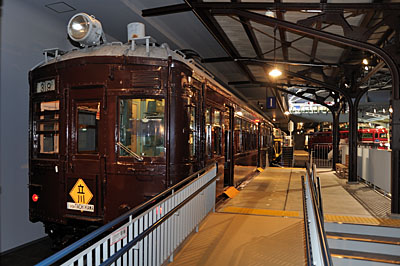
Electric Railcar
Class
|
Typical urban commuter electric car series in pre-WW2 (Ku = Driving car, Mo = Motor car, Ha = 3rd passenger class) |

|
|
Tokyo's urban neighborhood population saw rapid growth during 1910-1920.
Accordingly, with the increasing number of passenger transportation volume, there was a need for more train service. During 1928, Tokyo area's electrification power voltage was raised from 1200V to 1500V. However, the Tokyo urban lines could not accomodate the 20meter long body cars, as the platform or block lengths were not long enough. Therefore, in the Tokyo area, 17meter short body cars were used in new models up to 1933. However, the Osaka area used the 20meter class from the beginning. Originally, Osaka urban line's electrification was opened between Tennoji and Osaka on the Joto line (present Osaka-Kanjo line) on the 16th of February 1933. Series-40 railcars, out of a total of fifty, were completed at the time of electrification. Until then, 20meter steel cars underwent testing at various places, but during Osaka's electrification, they were used from the onset. The Tokyo area's track improvement construction was finished during 1933, and Series-40 classes were deployed to the Tokyo area from the next year 1934. The seven classses had a total of 425 Series-40 cars that were produced by 1940, and they were to become the standard model of urban commuter electric cars during the pre-WW2 period. Class MoHa-40 consisted of two-cabs, two-motors, and was used for 3rd class passenger use in the Series-40 railcar unit. Eighty cars (No.40001 - 40080) were manufactured between 1932 and 1936. Driving car's had the added letter "Ku". From this revision, Class MoHa-40 driving cars had the nomenclature, Class KuMoHa-40 from June of 1959. Series-40 were continuously used in the Tokyo and Osaka areas after WW2. However, they were gradually moved to local electrification lines after 1965. 200 Series-40 cars were still working on local lines during 1975. Of these, seventeen Class KuMoHa-40 were still active at the following places during 1976. However, the last Series-40 were retired during March 1987.
|
|
Preserved car No.KuMoHa-40074 (1936 - 1987)
The Museum exhibited Class KuMoHa-40 No.074, which was produced during 1936. After it's conception, it was a deployed to the Higashi-Kanagawa and Kamata depot and was active on the Keihin-Tohoku (Keihin) lines. Later, she was transferred to the Musashi-Koganei depot and went into the Chuo and Sobu lines and saw service up to or around 1965. After that, Chuo line trains were replaced by their heir model, but KuMoHa-40074 remained at the same Musashi-Koganei depot, and continued to work on a very short line consisting of 5.6 Km. This line was called the Shimogawara line and was a branch-line of the Chuo line. On the 1st of April 1973, Shimogawara line was closed and afterward on the 17th of November 1975 she was moved to the Kozu depot, and was used as a JR-staff commuter. KuMoHa-40074 was retired from all of her operations on the 30th of March 1987. But during the following year on the 21st of March 1988, she went back for restoration. Afterward, KuMoHa-40074 saw service as a JR event train with was mated with the KuMoHa-40054. But the service was shut down because of structural problems. Later she was kept at the Omiya General Rolling Stock Center and was exhibited in the new Museum after it's opening.
|
Introduction |
Go to Top |